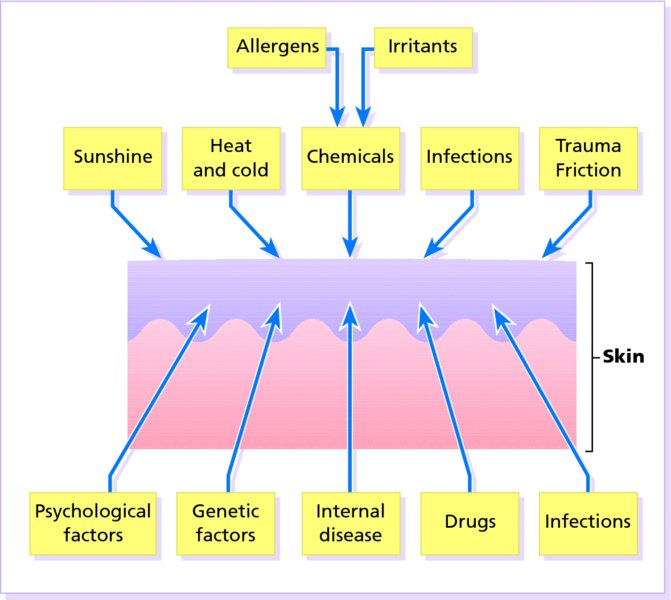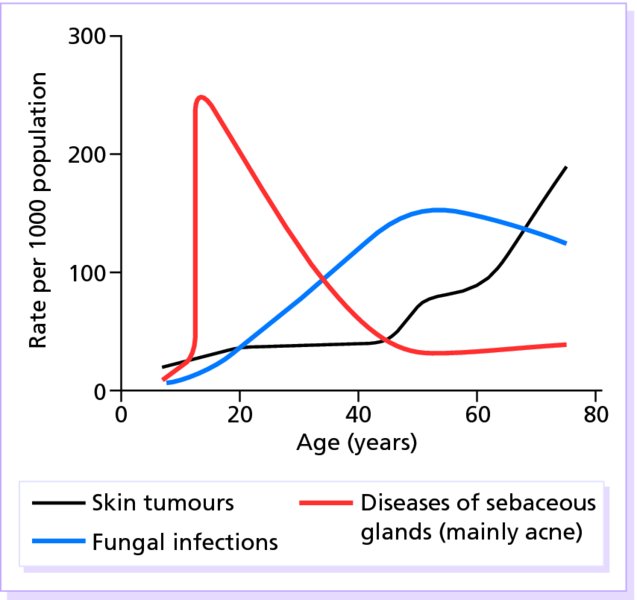1 This chapter presents an overview of the causes, prevalence and impact of skin disease. The skin is the largest organ in the body. It is the boundary between ourselves and the world around us, and its primary role is that of a barrier, preventing the entry of noxious chemicals and infectious organisms, and the exit of water and other chemicals. It is a sort of ‘space suit’, nicely evolved to house all the other organs and chemicals in our body. Skin has other roles too. It is an important sense organ, and controls heat and water loss. It reflects internal changes (see Chapter 21) and reacts to external ones. It can sweat, grow hair, erect its hairs, change colour, smell, grow nails, secrete sebum, synthesize vitamin D and release nitric oxide. When confronted with insults from outside, it usually adapts easily and returns to a normal state, but sometimes it fails to do so and a skin disorder appears. Some of the internal and external factors that are important causes of skin disease are shown in Figure 1.1. Often several will be operating at the same time. Just as often, however, no obvious cause for a skin abnormality can be found, and here lies much of the difficulty of dermatology. When a cause is obvious, for example when the washing of dishes leads to an irritant hand dermatitis, or when episodes of severe sunburn are followed by the development of a melanoma, education and prevention are just as important as treatment. Figure 1.1 Internal and external factors causing skin diseases. Skin diseases are very common. Probably everyone has experienced a skin disorder, such as sunburn, irritation, dry skin, acne, warts or pigment changes. The most common skin disorders in the United Kingdom are given in Table 1.1. People in other countries and in other environments may also develop skin diseases peculiar to their surroundings, or common skin diseases at different rates. For example, people living in tropical areas develop infectious diseases, such as leishmaniasis, not seen in more temperate climates. Different age groups experience different skin conditions. In the United States, for example, diseases of the sebaceous glands (mainly acne) peak at the age of about 18 years and then decline, while the prevalence of skin tumours steadily mounts with age (Figure 1.2). Table 1.1 The most common categories of skin disorder in the United Kingdom. Figure 1.2 The age-dependent prevalence of some skin conditions. The idea that ‘common things occur commonly’ is well known to surgeons as an aid to diagnosis. It is equally true of dermatology – an immense subject embracing more than 2000 conditions. In the United Kingdom some 70% of a dermatologist’s work is caused by only nine types of skin disorder (Table 1.1). Latest figures suggest that approximately one-quarter of the population of England and Wales, some 13 million people, will have a skin condition for which they will seek medical advice over a 12-month period. In the United States approximately one-third of the population has a skin disorder at any given time. The most recent estimate of the annual cost of skin disease in the United States was $39.3 billion dollars ($29.1 billion dollars in direct medical costs and $10.2 billion in lost productivity costs). Table 1.2 shows a breakdown of the top five most costly skin conditions seen in the United States. Table 1.2 Most costly skin conditions in the United States (2004). Adapted from Bickers et al. (2006). Reproduced with permission of Elsevier. In the United Kingdom, skin disorders are the most common reason for a patient to consult their general practitioner with a new problem; on average each general practitioner conducts over 600 consultations per year related to skin disorders. These figures are likely to be an under-estimation of the problem given the complexities of the classification of skin conditions. However, this is only the tip of an iceberg of skin disease, the sunken part of which consists of problems that never get to doctors, being dealt with or ignored in the community.
Skin Disease in Perspective
The many roles of the skin

The prevalence and cost of skin disorders
Skin cancer
Acne
Atopic eczema
Psoriasis
Viral warts
Other infective skin disorders
Benign tumours and vascular lesions
Leg ulcers
Contact dermatitis and other eczemas
Condition
Direct medical cost ($billions)
Skin ulcers/wounds
9.7
Acne
2.5
Herpes simplex/zoster
1.7
Cutaneous fungal infection
1.7
Contact dermatitis
1.6
Stay updated, free articles. Join our Telegram channel

Full access? Get Clinical Tree








